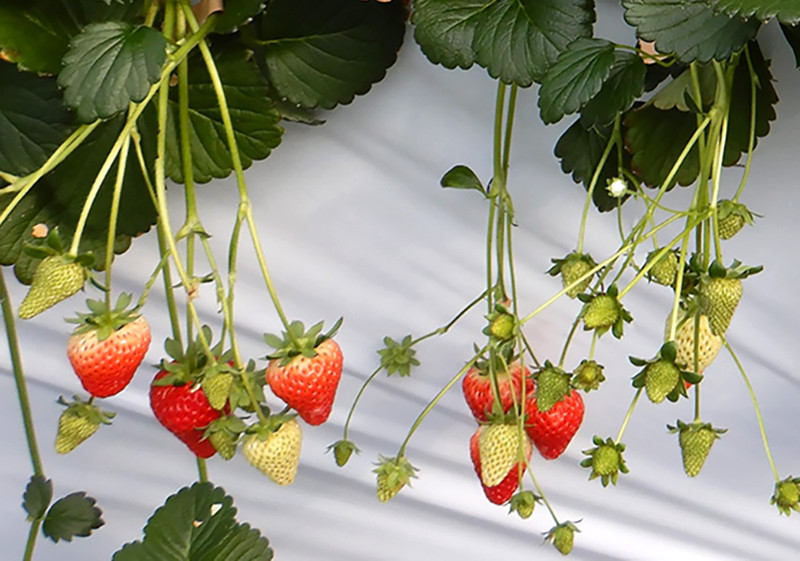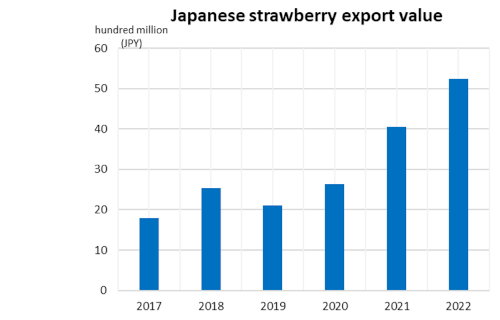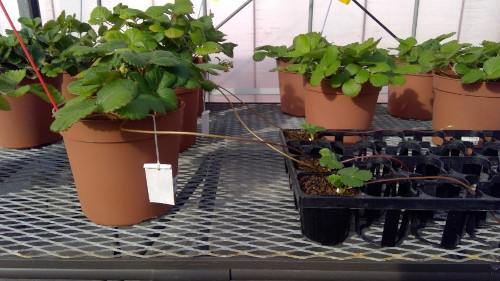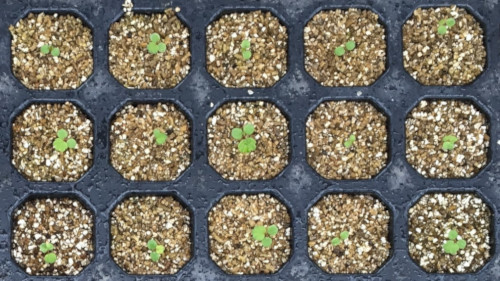
In November, 2023, Sakata Seed Corporation will start an activity to commercialize F1 seed strawberry varieties suitable for greenhouse cultivation in the near future.
Japanese strawberry varieties are highly praised internationally for their delicious flavor. However, Japanese strawberry varieties are also characterized by their softness, which creates issues in regard to shelf life and transportability. Furthermore, diseases that are likely to cause problems during cultivation vary by region. Sakata Seed Corporation began planning strawberry breeding in 2016 and started it in 2018. Our aim is to breed strawberry varieties which balance outstanding flavor unique to Japanese strawberries and transportability, and which possess disease resistance required in areas where they are grown. In 2017, Sakata Seed Corporation won the permission to sell seeds and seedlings of Yotsuboshi, an F1 seed strawberry developed by Mie Prefecture, Kagawa Prefecture, Chiba Prefecture and Kyushu Okinawa Agricultural Research Center, and sold it mainly in Canada and the United States, gaining insight into the demand in each region.
Conventionally, many vegetative varieties of strawberries propagated from parent plants have been used around the world. However, vegetative propagation has the following issues: (1) effort required to
manage the parent plant and collect the young plants, (2) risk of disease infection from the parent plant, and (3) restrictions on the season of transplanting young plants. To solve these problems, Sakata Seed Corporation is working to develop F1 seed strawberry varieties (ever bearing) that can be raised from seeds. We have already begun trial production on a global scale.
In order to further accelerate the movement toward commercialization, we have recently started an activity that unifies research, production, and sales. Our entire company will work toward the commercialization of our F1 seed strawberry business.
Global potential of the Japanese strawberry
In Japan, strawberries are mainly eaten raw. New varieties are developed every year, and the flavor of Japanese strawberries is among the highest in the world. Statistics show that the export value of strawberries from Japan has rapidly increased from 1,798.53 million yen in 2017 to 5,241.63 million yen in 2022(*). Overseas demand for Japanese strawberries is expected to continue increasing in the future.
On the other hand, cultivating Japanese strawberry varieties around the world can be difficult. In addition to licensing issues, there are also differences in required disease resistance and transportability of fruits. Sakata Seed Corporation will continue to develop varieties with the aim of achieving both the outstanding flavor unique to Japanese strawberries, as well as the disease resistance and transportability required in regions where they are grown.
-
*
Calculated based on the Statistical Yearbook of Ministry of Agriculture, Forestry and Fisheries

Possibilities of seed-propagated strawberry varieties
Conversely, the use of seed-propagated strawberries reduces cultivation labor such as management of parent plants, management of pest and disease infection when maintaining parent plants, and harvesting of child plants. This also leads to a reduction in the amounts of pesticides used. Moreover, using seed propagation significantly shortens the period for raising young plants to approximately 2 to 3 months, compared to more than 6 months with vegetative propagation. When propagating with runners, the season for raising young plants is limited. On the other hand, when using seed propagation, it is easy to control the periods for sowing and raising seedlings. Therefore, in addition to being used for normal greenhouse cultivation, seed propagation is also suitable for use in completely enclosed plant factories where turnover rate and profitability are prioritized.

Strawberry propagation using runners

Seed germination
Seed-propagated strawberries and plant factories
A completely enclosed plant factory is a facility for maximizing the characteristics of seed-propagated strawberries. A completely enclosed plant factory conducts artificial management of factors such as light, temperature, and water within the building. One advantage is that it is difficult for pests and diseases to infiltrate the factory, unlike open fields or greenhouses. For this reason, we believe that many business are looking for seed-propagated strawberry varieties with no risk of infection from parent plants due to extremely strict measures to prevent the entry of external pests and diseases. When considering how the yield per area in plant factories is linked more directly to business performance than in open fields or greenhouses, another advantage of seed-propagated strawberries is that less space is required to raise seedlings compared to vegetative propagation.
Further expansion of demand for Japanese strawberries: Tomoji Nakai, Senior General Manager of Overseas Sales & Marketing Division, Sakata Seed Corporation
“As a global seed company based in Japan, Sakata Seed Corporation has developed and supplied a variety of new vegetable and flower products to the market. For strawberries which are very popular fruit in the world, we are developing F1 seed strawberry that combines the delicious flavor of Japanese strawberries with improved disease resistance and transportability. Through these new varieties, we aim to reduce the burden on producers and the environment impact, and to stimulate demand for high-quality strawberries and expand the market. By combining our breeding, supply chain, sales, product development teams that we have strengthened until now, we aim to become the world’s leading strawberry seed company.
(Tomoji Nakai, Senior Executive Officer, Senior General Manager of Overseas Sales & Marketing Division, Sakata Seed Corporation)